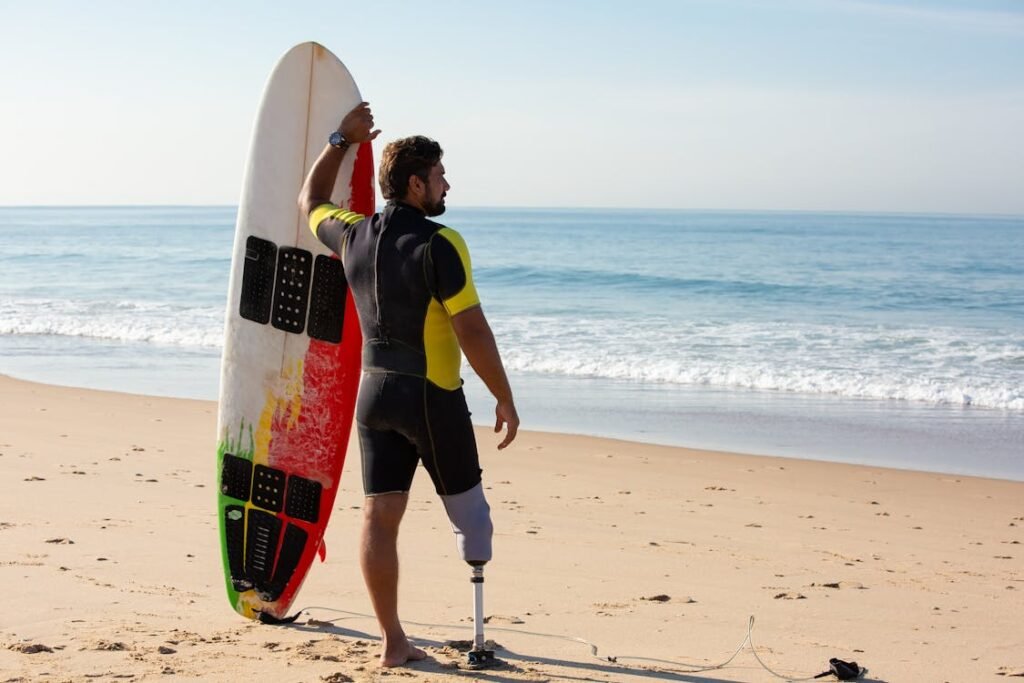Sports push the limits of the human body, requiring agility, strength, and endurance. For athletes with limb loss, having the right prosthetic can mean the difference between peak performance and discomfort. High-impact sports like running, basketball, and martial arts demand prosthetics that not only offer stability but also absorb shock efficiently. The right prosthetic can reduce strain on the body, improve comfort, and enhance overall performance.
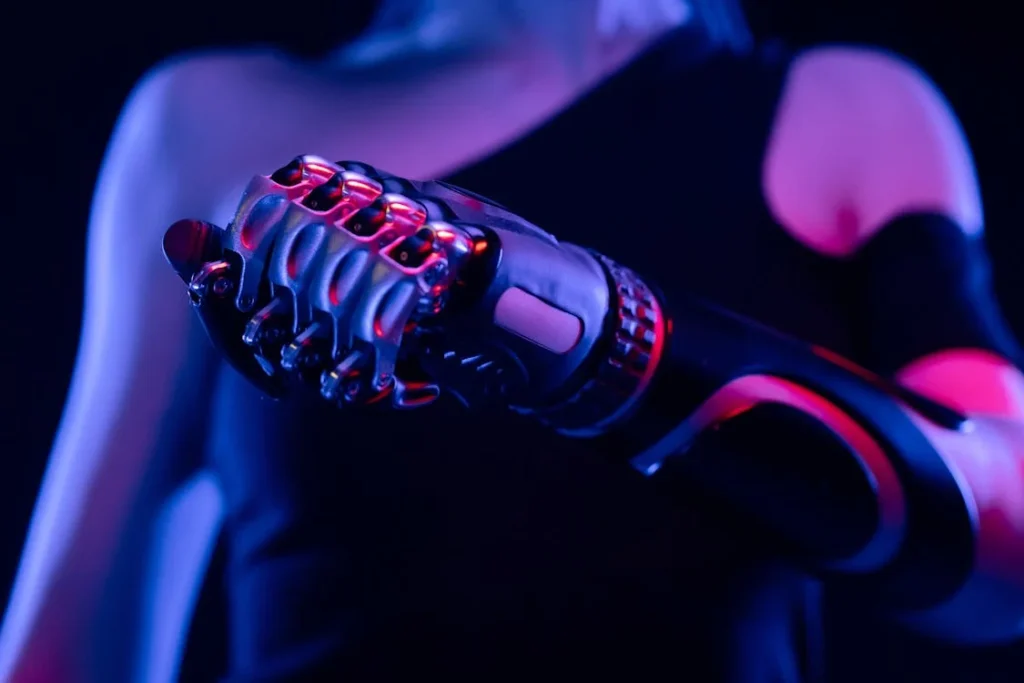
Understanding Shock Absorption in Prosthetics
When engaging in high-impact sports, every movement generates force. Activities like sprinting, jumping, or sudden directional changes create a strong impact that travels through the prosthetic and into the residual limb.
Without proper shock absorption, these forces can lead to discomfort, joint strain, and even long-term injuries. This is why prosthetic technology must incorporate materials and designs that effectively absorb and distribute shock.
Shock absorption in prosthetics is achieved through a combination of advanced materials, mechanical engineering, and ergonomic design. The right prosthetic does not just absorb impact—it also returns energy efficiently.
This energy return helps athletes move with greater ease, reducing fatigue and improving performance. By minimizing the stress on joints, shock-absorbing prosthetics allow users to train harder and recover faster, making them essential for high-impact sports.
How Shock Absorption Works in Prosthetic Technology
The science behind shock absorption in prosthetics is similar to how high-performance running shoes reduce impact on a runner’s joints.
Materials such as carbon fiber and elastomers are used to create prosthetic components that flex and absorb impact while maintaining durability.
The foot and socket of the prosthetic play a significant role in dispersing force, ensuring that the impact does not directly transfer to the residual limb.
Many modern prosthetics also feature hydraulic or pneumatic shock absorbers, which further reduce stress on the body. These systems work by compressing and controlling the release of energy, allowing smoother movements.
This is particularly important for athletes involved in sports like basketball, where repetitive jumping and landing can place immense pressure on the body.
By integrating these technologies, prosthetic limbs can function more like natural limbs, making movement feel effortless and reducing the risk of injury.
Why Shock Absorption Matters for Athletes
Athletes need consistency in performance. A prosthetic that lacks proper shock absorption can lead to instability, causing discomfort and making it harder to focus on the sport.
Over time, excessive impact on the residual limb can lead to skin irritation, pain, and even long-term musculoskeletal issues. By choosing a prosthetic with high shock-absorption capabilities, athletes can train longer without unnecessary strain.
For runners, a prosthetic with good energy return helps maintain stride efficiency, preventing energy loss with each step. In sports like football or rugby, where sudden impacts and directional changes are frequent, the right prosthetic can provide better control and balance.
Martial artists, who rely on quick footwork and dynamic movements, benefit from a prosthetic that can handle rapid changes in momentum while keeping stress on the joints minimal.
Advancements in Prosthetic Design for High-Impact Sports
The field of prosthetics has evolved significantly, with new materials and designs allowing athletes to perform at elite levels. At Robobionics, we prioritize innovation, ensuring that athletes receive prosthetics designed to keep up with their ambitions.
Our prosthetic limbs integrate lightweight, flexible components that mimic the movement of natural limbs while reducing impact.
Customization plays a key role in optimizing performance. Every athlete has different needs based on their sport, body type, and movement style.
A well-fitted prosthetic, designed specifically for an individual’s biomechanics, enhances shock absorption and provides superior comfort.
This is why professional athletes work closely with prosthetists to fine-tune their devices, ensuring they get the best possible performance from their prosthetics.
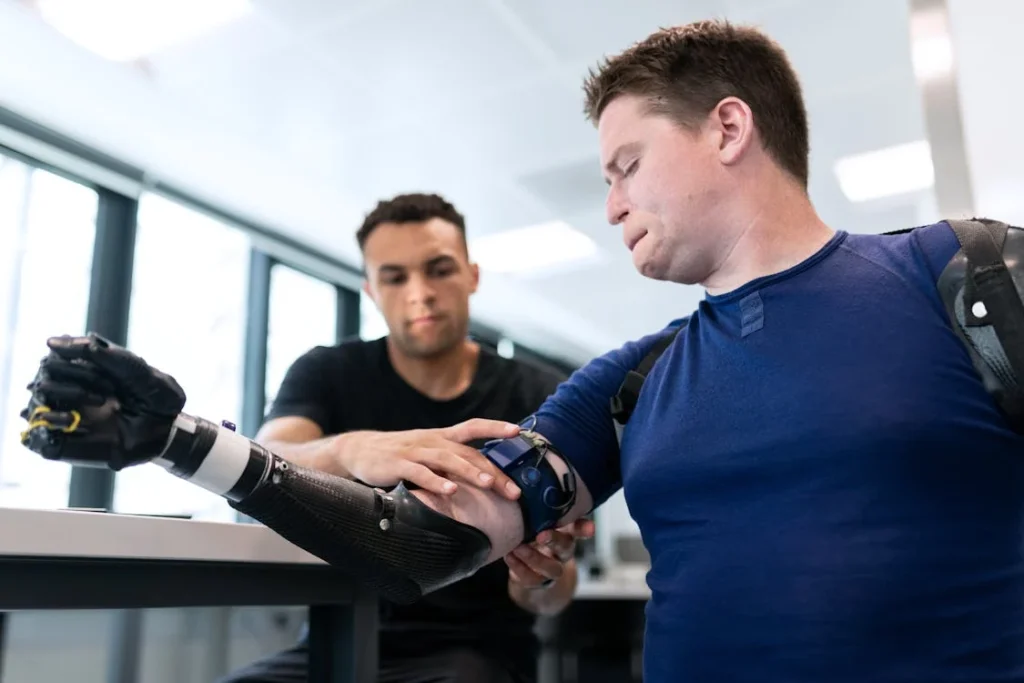
Key Features of Shock-Absorbing Prosthetics for Athletes
A high-performance prosthetic for sports needs to do more than just provide mobility. It must be able to handle intense physical activity while keeping the athlete safe and comfortable.
The best prosthetics for high-impact sports incorporate several features that work together to reduce stress on the body and improve overall efficiency.
One of the most important features is energy return technology. In simple terms, this means the prosthetic absorbs impact when the athlete moves and then releases that energy to propel them forward.
This is crucial for sports like running and sprinting, where every step generates force that, if not managed properly, could slow the athlete down. Carbon fiber blades, for example, are designed to flex and spring back, providing athletes with a natural and powerful stride.
Another essential feature is adaptive shock absorption. Unlike regular prosthetic limbs, which may feel stiff or unresponsive, advanced models use hydraulic or pneumatic systems to absorb impact and adjust to different surfaces.
This allows athletes to move smoothly, whether they are running on a track, jumping on a court, or shifting directions on a field. Without this feature, the body would have to compensate for the lack of flexibility, leading to fatigue and a higher risk of injury.
A well-designed socket system also plays a crucial role in shock absorption. Since the socket is the connection point between the prosthetic and the residual limb, it must fit perfectly to prevent excessive movement or pressure.
Poorly fitted sockets can lead to discomfort, blisters, and even skin breakdown, all of which can significantly affect performance. At Robobionics, we emphasize custom-fit sockets that distribute pressure evenly and allow for better shock absorption.
This ensures athletes can move with confidence, knowing their prosthetic is secure and comfortable.
Choosing the Right Prosthetic Based on Sport
Different sports place different demands on the body, which means not all prosthetics are designed the same way.
A prosthetic that works well for a sprinter may not be suitable for a basketball player, and vice versa. Understanding these differences is key to selecting the right prosthetic for your sport.
For runners, the focus is on lightweight materials and high energy return. Running blades made from carbon fiber are ideal because they allow for a natural, spring-like motion that minimizes impact on the joints.
These blades are shaped to mimic the mechanics of a natural foot, ensuring a smooth stride while reducing stress on the residual limb.
For basketball and other court sports, a prosthetic with strong shock absorption and lateral stability is necessary. Since these sports involve constant jumping, landing, and quick changes in direction, a well-cushioned foot with adaptive technology is ideal.
Hydraulic or pneumatic components can help absorb impact while allowing controlled movement.
For contact sports like football and rugby, durability and flexibility are top priorities. These sports involve a lot of force, so the prosthetic must be able to handle impact while maintaining balance and agility.
Reinforced materials combined with energy-absorbing mechanisms help prevent injuries and allow athletes to react quickly to fast-paced movements.
For martial arts and combat sports, a prosthetic with a high range of motion and excellent shock absorption is essential.
These sports require fast, multidirectional movement, which means the prosthetic must allow for smooth transitions between offensive and defensive stances. Prosthetics with a rotating ankle joint and responsive cushioning can help martial artists maintain their agility and precision.
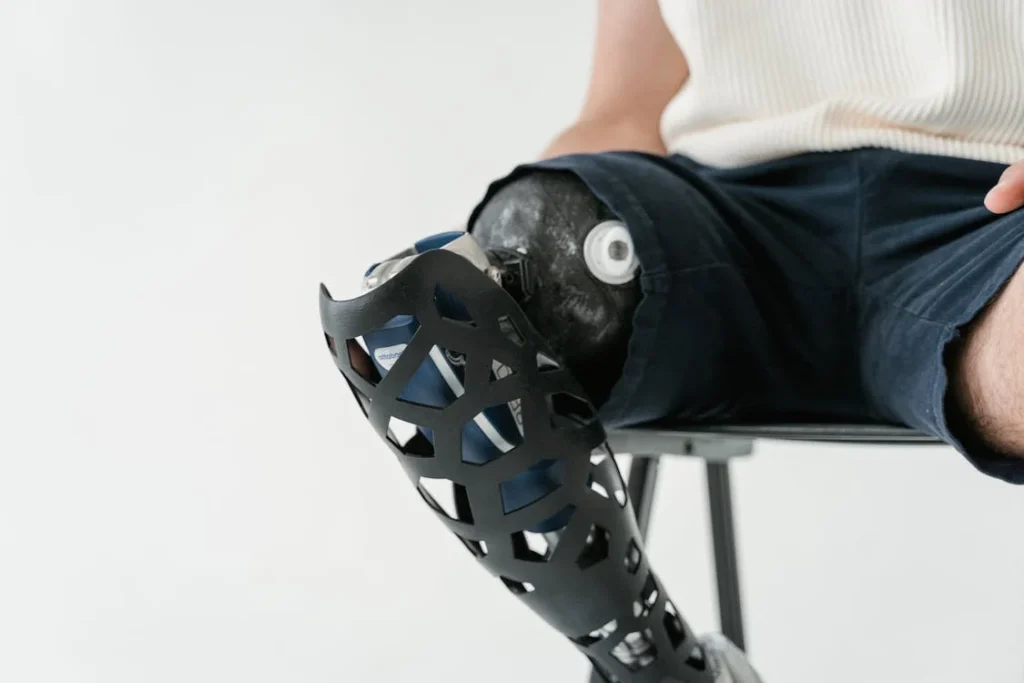
The Role of Customization in Performance and Comfort
No two athletes are the same, which is why customization is a key factor in maximizing performance with prosthetics. A prosthetic limb that is tailored to an athlete’s specific needs will always outperform a generic model.
The shape of the residual limb, the type of sport, the intensity of movement, and the personal preferences of the athlete all influence what kind of prosthetic will work best.
A customized prosthetic takes into account not just shock absorption, but also fit, flexibility, and weight distribution. If the prosthetic is too rigid, it can cause discomfort and increase strain on the joints. If it is too flexible, it may not provide enough support.
Balance is everything. At Robobionics, we work closely with athletes to fine-tune these elements, ensuring a perfect match between the prosthetic and their natural movements.
Another major factor in customization is socket design. The socket is where the prosthetic attaches to the residual limb, and if it does not fit well, the athlete will experience discomfort and potential skin issues.
A properly designed socket should distribute pressure evenly, minimize friction, and allow for airflow to keep the skin cool and dry. Advanced prosthetic sockets now use vacuum suspension systems or gel liners, which improve comfort and reduce the risk of irritation.
Athletes who participate in different types of sports may also need interchangeable components. For example, a runner might use a carbon fiber blade for track events but switch to a more cushioned foot for daily activities.
Modular designs allow athletes to swap out different parts of their prosthetic depending on their needs, ensuring they always have the right tool for the job.
Overcoming Challenges in High-Impact Sports with Prosthetics
Even with the best technology, athletes with prosthetics face unique challenges when competing in high-impact sports. One of the biggest challenges is maintaining balance and stability during rapid movements.
Since prosthetics do not have the same sensory feedback as natural limbs, athletes must rely on muscle memory and core strength to stay in control. Training and rehabilitation play a crucial role in helping athletes adapt to their prosthetic and refine their movements.
Another common challenge is managing impact stress on the residual limb. While advanced shock-absorbing technology helps reduce strain, repeated high-impact movements can still cause discomfort over time.
This is why proper rehabilitation and strengthening exercises are essential. Athletes should work on core stability, flexibility, and endurance training to build strength in surrounding muscles and reduce the risk of overuse injuries.
Weather conditions can also affect prosthetic performance. In extreme heat, some prosthetic materials may expand slightly, altering the fit. In cold weather, materials can become stiffer, impacting flexibility.
Choosing a prosthetic made from durable, all-weather materials helps maintain consistency in performance. Athletes should also pay close attention to maintenance and adjustments, ensuring their prosthetic remains in peak condition throughout the season.
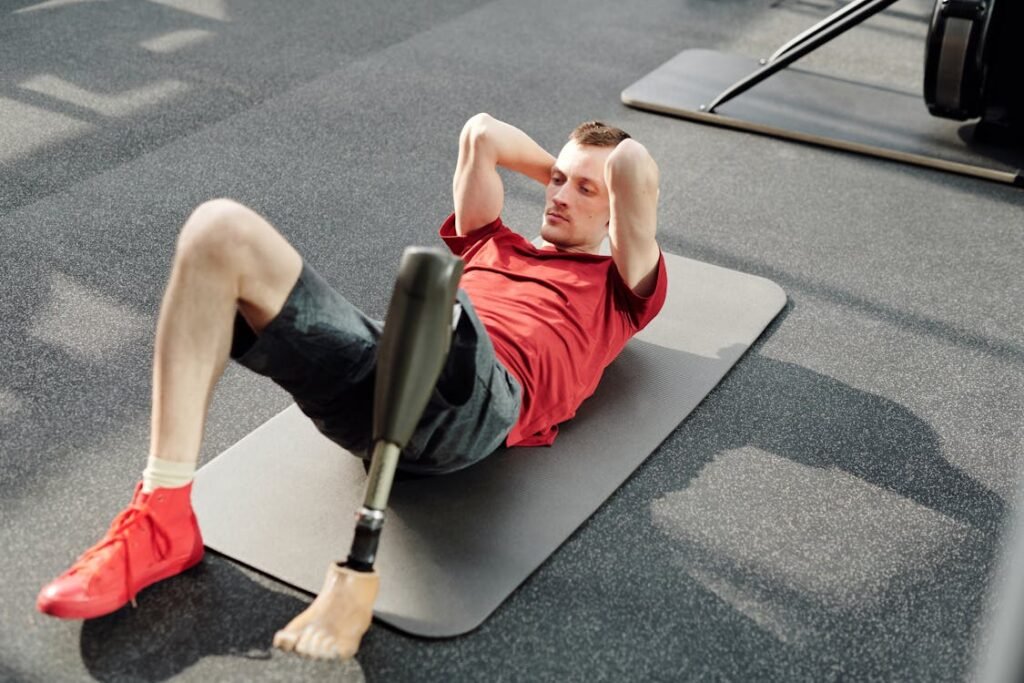
Training and Rehabilitation for High-Impact Sports with Prosthetics
Having a high-performance prosthetic is only part of the equation. Proper training and rehabilitation are just as important for athletes looking to excel in high-impact sports.
Adapting to a shock-absorbing prosthetic takes time, and working with professionals—such as physiotherapists, prosthetists, and sports trainers—can significantly improve performance.
One of the first steps in training is building core strength and stability. Since the prosthetic does not provide the same natural feedback as a biological limb, athletes must rely on their core muscles for balance and coordination.
Exercises like planks, stability ball drills, and resistance band work help strengthen the muscles that support movement, making transitions smoother and reducing the risk of falls.
Another crucial area of focus is proprioception, or the body’s ability to sense its position in space. With a prosthetic, proprioception must be actively developed through training. Balance exercises, agility drills, and controlled movements help athletes fine-tune their muscle memory,
allowing them to react instinctively in fast-paced situations. Gamified rehabilitation programs, like the ones offered by Robobionics, make this process more engaging by incorporating interactive activities that improve responsiveness and adaptability.
Athletes also benefit from sport-specific training, which tailors their workout routines to the demands of their chosen sport.
A sprinter, for instance, will focus on explosive movements and short bursts of speed, while a basketball player may work on lateral movements and quick directional changes.
Practicing real-game scenarios with the prosthetic allows the athlete to become more comfortable and confident in their movements.
The Psychological Aspect of Competing with a Prosthetic
Beyond the physical aspect, there is a significant mental component to excelling in sports with a prosthetic. Athletes must build confidence in their ability to compete and trust their prosthetic to perform under pressure.
Mental training techniques, such as visualization, mindfulness, and goal-setting, help athletes stay focused and motivated.
It is common for athletes to face moments of doubt or frustration, especially when adjusting to a new prosthetic or recovering from an injury.
Having a strong support system—including coaches, teammates, family, and fellow amputee athletes—can make a huge difference in staying positive and pushing forward.
At Robobionics, we believe in empowering athletes to see their prosthetic not as a limitation, but as an extension of their potential.
Our advanced prosthetic designs, combined with personalized training and rehabilitation, help athletes overcome obstacles and achieve their goals.
The Future of Shock-Absorbing Prosthetics in Sports
The field of sports prosthetics continues to evolve, with new materials and technology making prosthetics lighter, stronger, and more adaptable than ever before.
Researchers and engineers are constantly exploring ways to enhance shock absorption, energy return, and biomechanical efficiency.
One exciting area of development is smart prosthetics, which integrate sensors and AI-driven systems to provide real-time feedback. These prosthetics can adjust to different terrains, track an athlete’s movement patterns, and even suggest adjustments to improve performance.
As technology advances, the gap between prosthetic and biological limbs continues to shrink, allowing athletes to compete at increasingly higher levels.
At Robobionics, we are committed to staying at the forefront of these innovations. Our goal is to create prosthetics that empower athletes to push their limits, break barriers, and redefine what is possible.
Whether you are an aspiring athlete or a seasoned competitor, we are here to help you find the perfect prosthetic solution for your sport.
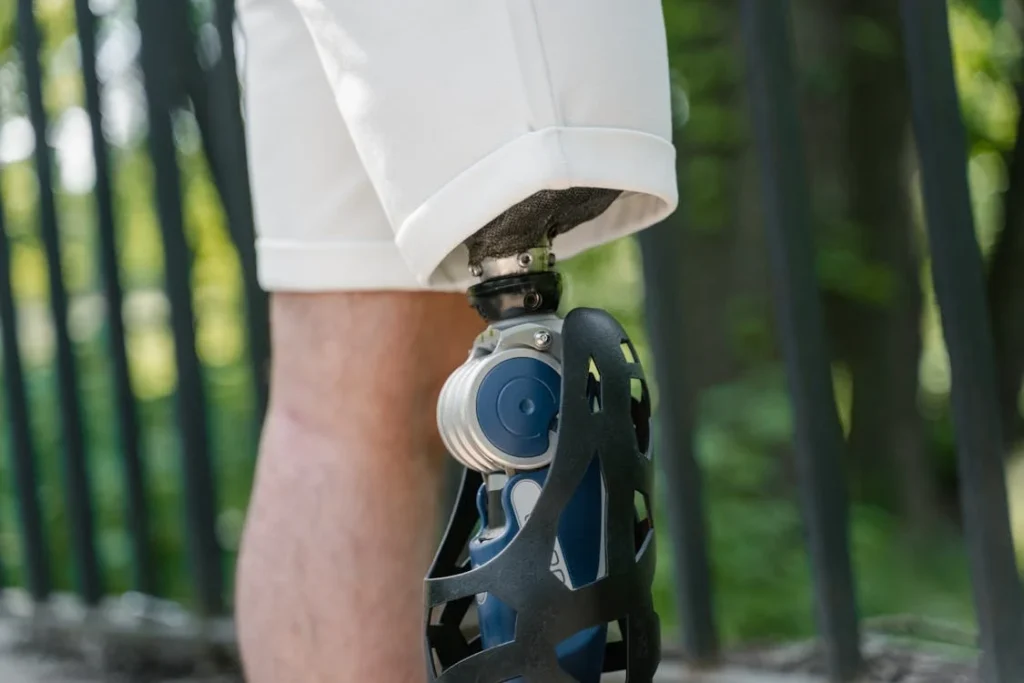
The Impact of Shock-Absorbing Prosthetics on Injury Prevention
One of the biggest challenges athletes with prosthetics face in high-impact sports is injury prevention.
While sports put a strain on any athlete’s body, those using prosthetic limbs must manage additional factors such as force distribution, residual limb health, and long-term joint care.
The right shock-absorbing prosthetic plays a critical role in reducing the risk of injuries, ensuring that athletes can train and compete safely for years to come.
Reducing Strain on Joints and the Residual Limb
Every time an athlete runs, jumps, or pivots, they generate impact forces that travel through their body. In a natural limb, muscles, tendons, and joints work together to absorb and distribute these forces.
For an athlete using a prosthetic, the way these forces are handled depends entirely on the prosthetic’s design.
Without proper shock absorption, these repeated impacts can cause stress injuries to the residual limb, leading to discomfort and even long-term musculoskeletal problems.
A well-designed shock-absorbing prosthetic reduces this risk by effectively dampening impact forces before they reach the residual limb.
Advanced materials like carbon fiber composites and elastomers help dissipate energy upon impact, preventing excessive force from being transferred to the body.
Additionally, hydraulic and pneumatic shock absorbers mimic the function of natural joints, allowing for smoother landings and transitions. This is especially important in sports that involve frequent jumping, such as basketball and long-distance running.
Preventing Skin and Soft Tissue Injuries
Skin health is another major concern for athletes using prosthetics. The residual limb is subjected to pressure, friction, and heat buildup during intense physical activity. If a prosthetic does not absorb shock efficiently, it can create hotspots that lead to blisters, sores, or skin breakdown.
Over time, repeated trauma to the skin can force an athlete to take extended breaks from training, disrupting their progress.
Shock-absorbing prosthetics help mitigate this issue by distributing pressure more evenly across the socket interface. Gel liners and vacuum suspension systems can further enhance comfort by reducing friction and providing cushioning between the limb and the prosthetic.
Athletes must also pay close attention to proper hygiene and fit adjustments, ensuring that their prosthetic remains secure without causing unnecessary irritation.
Long-Term Protection Against Overuse Injuries
Overuse injuries are a common problem in high-impact sports, even for able-bodied athletes. However, for those using prosthetics, the risk is often heightened due to asymmetrical movement patterns.
If a prosthetic does not absorb shock effectively, an athlete may unconsciously compensate by placing more strain on their intact limb. This imbalance can lead to issues such as knee pain, lower back strain, and hip misalignment over time.
To prevent these complications, modern prosthetics incorporate dynamic energy return systems, which allow for smoother weight transitions and more balanced movement.
By reducing the need for compensatory movements, these prosthetics help athletes maintain proper biomechanics, minimizing the risk of long-term injuries.
Strength training and gait analysis can also help athletes fine-tune their form, ensuring that they move efficiently without placing unnecessary stress on certain muscle groups.
Rehabilitation and Injury Recovery with Prosthetic Technology
In the event of an injury, rehabilitation plays a crucial role in helping athletes regain strength and confidence.
Shock-absorbing prosthetics can aid in the recovery process by reducing impact forces, allowing athletes to ease back into their training without putting excessive strain on their bodies.
Additionally, adaptive prosthetic components allow for gradual progression. For example, a recovering athlete might start with a prosthetic that offers maximum cushioning before transitioning to a high-energy-return model as they rebuild strength.
At Robobionics, we work closely with athletes to tailor their prosthetic setup based on their recovery stage, ensuring a safe and effective return to sport.
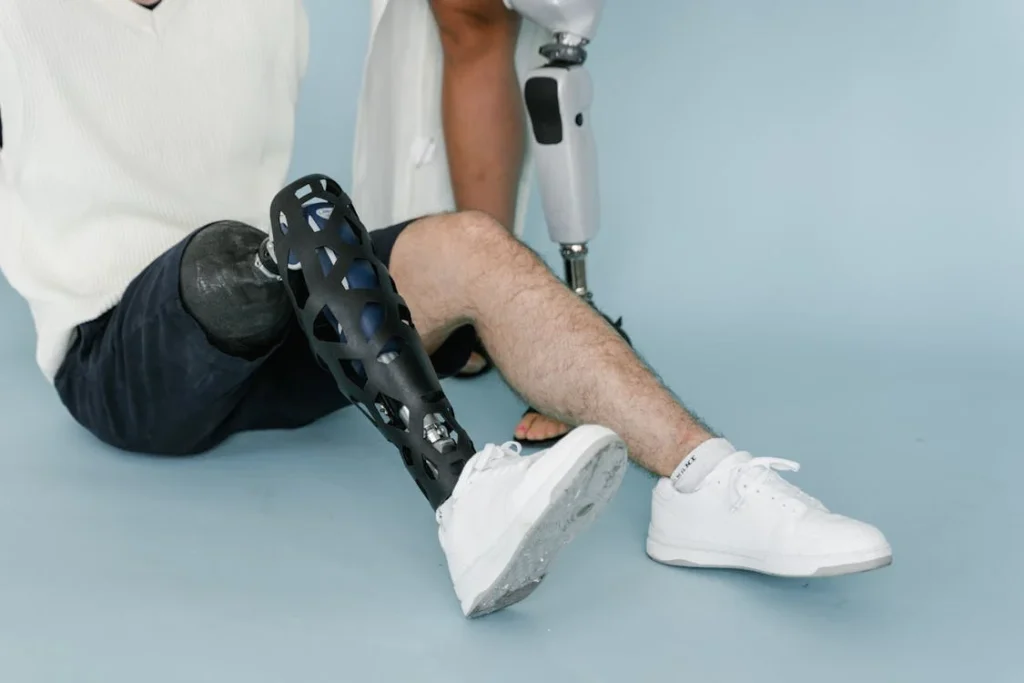
The Science Behind Energy Return in Shock-Absorbing Prosthetics
Beyond just absorbing impact, the best prosthetics for high-impact sports also return energy efficiently. This concept, known as energy return, is what allows athletes to move with power and efficiency while reducing fatigue.
Unlike traditional prosthetics that simply cushion impact, energy-returning prosthetics store kinetic energy and release it at the right moment, mimicking the natural function of muscles and tendons.
How Energy Return Works in Prosthetic Technology
In a natural limb, the muscles and tendons act like springs, storing energy when compressed and releasing it when extended.
This is particularly evident when running—every time a runner’s foot hits the ground, the calf muscles absorb energy and then push off to propel the body forward. A high-performance prosthetic replicates this process using specialized materials and engineering.
Carbon fiber prosthetics are a prime example of this technology. Carbon fiber is both lightweight and highly elastic, allowing it to bend under pressure and snap back to its original shape almost instantly.
This means that when an athlete lands from a jump or takes a stride, the prosthetic absorbs energy and releases it as forward motion, reducing the amount of effort required for each step.
Advanced prosthetics also incorporate lever systems and tuned stiffness levels to optimize energy return based on the athlete’s weight, sport, and movement style.
These features allow for fine-tuned performance, ensuring that energy is neither lost nor overly exaggerated in a way that could cause instability.
The Benefits of Energy-Returning Prosthetics in High-Impact Sports
One of the biggest advantages of energy return technology is enhanced endurance. Since the prosthetic helps propel the athlete forward, less muscular effort is required to maintain movement.
This allows athletes to conserve energy, extend their training sessions, and maintain peak performance for longer durations.
For sprinters and runners, energy return translates into explosive speed and efficient strides. Every step on the track benefits from the stored energy in the prosthetic, creating a smoother and faster motion.
This is why elite Paralympic sprinters use blade-style prosthetics that maximize energy return with each footstrike.
In jumping sports like basketball and long jump, energy return prosthetics enable athletes to generate greater vertical lift while also cushioning the landing. The stored energy provides extra push-off power, giving athletes a competitive edge in height and reach.
For court and field sports, where rapid changes in direction are crucial, prosthetics with controlled energy return help maintain agility. These prosthetics allow for quick acceleration and deceleration, making movements feel more natural and reducing the risk of overexertion.
Finding the Right Balance Between Shock Absorption and Energy Return
While shock absorption and energy return are closely linked, they must be balanced carefully to meet the demands of different sports.
A prosthetic designed for long-distance running, for example, may prioritize energy return to maintain endurance, while a prosthetic for high-impact landings, such as gymnastics or parkour, will emphasize shock absorption to prevent excessive strain.
This is where custom tuning becomes essential. Prosthetists and engineers fine-tune prosthetic stiffness, flexibility, and rebound characteristics to match the athlete’s sport and biomechanics.
At Robobionics, we work closely with athletes to ensure their prosthetics provide the perfect combination of comfort, shock absorption, and energy return.
Conclusion
High-impact sports demand more than just strength and endurance—they require technology that moves with the athlete, not against them. Shock-absorbing prosthetics play a crucial role in reducing strain, improving comfort, and enhancing performance. With advanced materials, energy return technology, and customized designs, today’s prosthetics allow athletes to push their limits like never before.
At Robobionics, we believe that prosthetics should empower, not restrict. Whether you’re sprinting on the track, maneuvering on the court, or taking on extreme sports, the right prosthetic makes all the difference. Our commitment to innovation ensures that every athlete gets a prosthetic tailored to their needs, maximizing both shock absorption and energy return for optimal performance.
The future of sports prosthetics is evolving rapidly, and we’re here to help athletes stay ahead of the curve. If you’re ready to experience the next level of prosthetic technology, contact us today and take the first step toward redefining your game. Book a free demo of Grippy™ and feel the difference firsthand!



